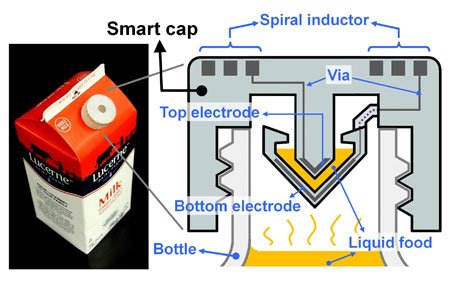Prosthetics, medical implants and toys are all fantastic but what had been missing from the repertoire until now was the ability to produce sensitive electronic components.
“Our paper describes the first demonstration of 3D printing for working basic electrical components, as well as a working wireless sensor,” said senior author Liwei Lin, a professor of mechanical engineering and co-director of the Berkeley Sensor and Actuator Center. “One day, people may simply download 3D-printing files from the Internet with customized shapes and colors and print out useful devices at home.”

UC Berkeley engineers created a ‘smart cap’ using 3D-printed plastic with embedded electronics to wirelessly monitor the freshness of milk. Photo and schematic by Sung-Yueh Wu
Polymers are attractive materials in the world of 3D printing because their flexibility allows them to be formed into a variety of shapes. However, such materials are poor conductors of electricity, and thus bad candidates for electronic devices. To get around this, the researchers started off by building a system using polymers and wax. They would then remove the wax, leaving hollow tubes into which liquid metal – in their experiments they used silver – was injected and then cured. The shape and design of the metal determined the function of different electrical components. For instance, thin wires acted as resistors, and flat plates were made into capacitors.
But the question remained: Do the pieces of metal actually do anything useful? To answer that, the researchers integrated the electronic components into a plastic milk carton cap to monitor signs of spoilage. The “smart cap” was fitted with a capacitor and an inductor to form a resonant circuit. A quick flip of the carton allowed a bit of milk to get trapped in the cap’s capacitor gap, and the entire carton was then left unopened at room temperature (about 71.6 degrees Fahrenheit) for 36 hours. The circuit could detect the changes in electrical signals that accompany increased levels of bacteria.
The researchers periodically monitored the changes with a wireless radio-frequency probe at the start of the experiment and every 12 hours thereafter, up to 36 hours. The property of milk changes gradually as it degrades, leading to variations in its electrical characteristics. Those changes were detected wirelessly using the smart cap, which found that the peak vibration frequency of the room-temperature milk dropped by 4.3 percent after 36 hours. In comparison, a carton of milk kept in refrigeration at 39.2 degrees Fahrenheit saw a relatively minor 0.12 percent shift in frequency over the same time period.
Lin said his lab is working on developing this technology for health applications, such as implantable devices with embedded transducers that can monitor blood pressure, muscle strain and drug concentrations.
Citation: Sung-Yueh Wu, Chen Yang, Wensyang Hsu, Liwei Lin, 3D-printed microelectronics for integrated circuitry and passive wireless sensors, Microsystems&Nanoengineering, Article number: 15013 (2015) doi:10.1038/micronano.2015.13






Comments